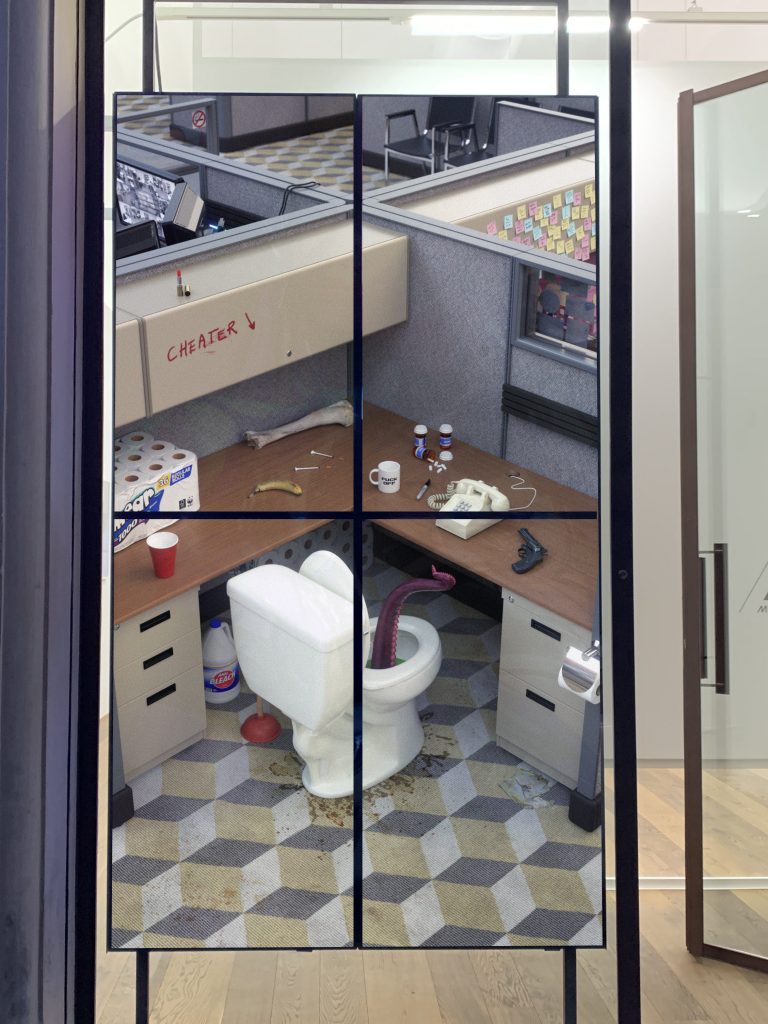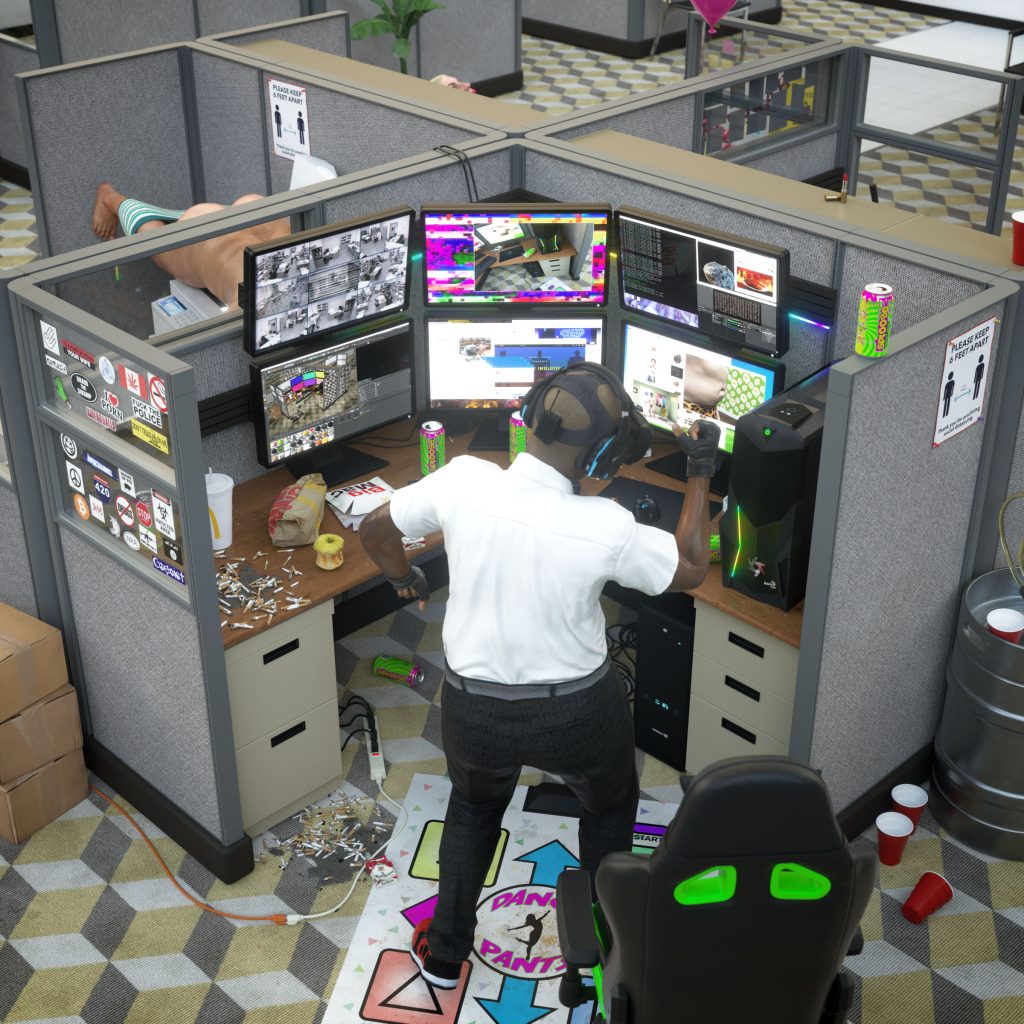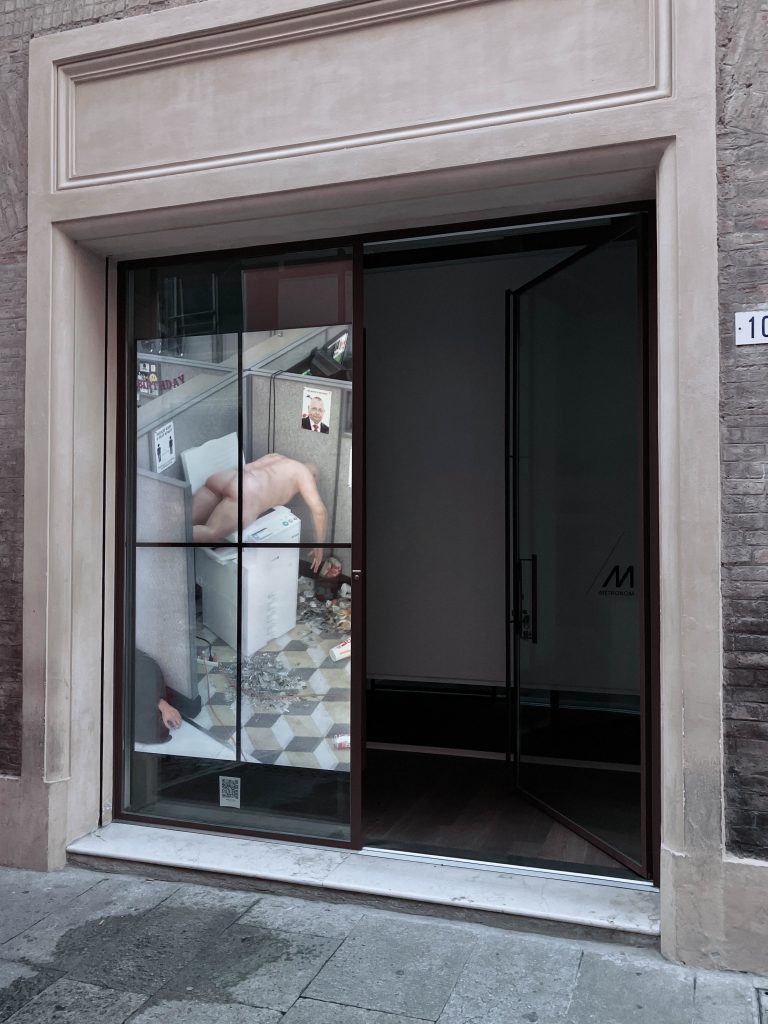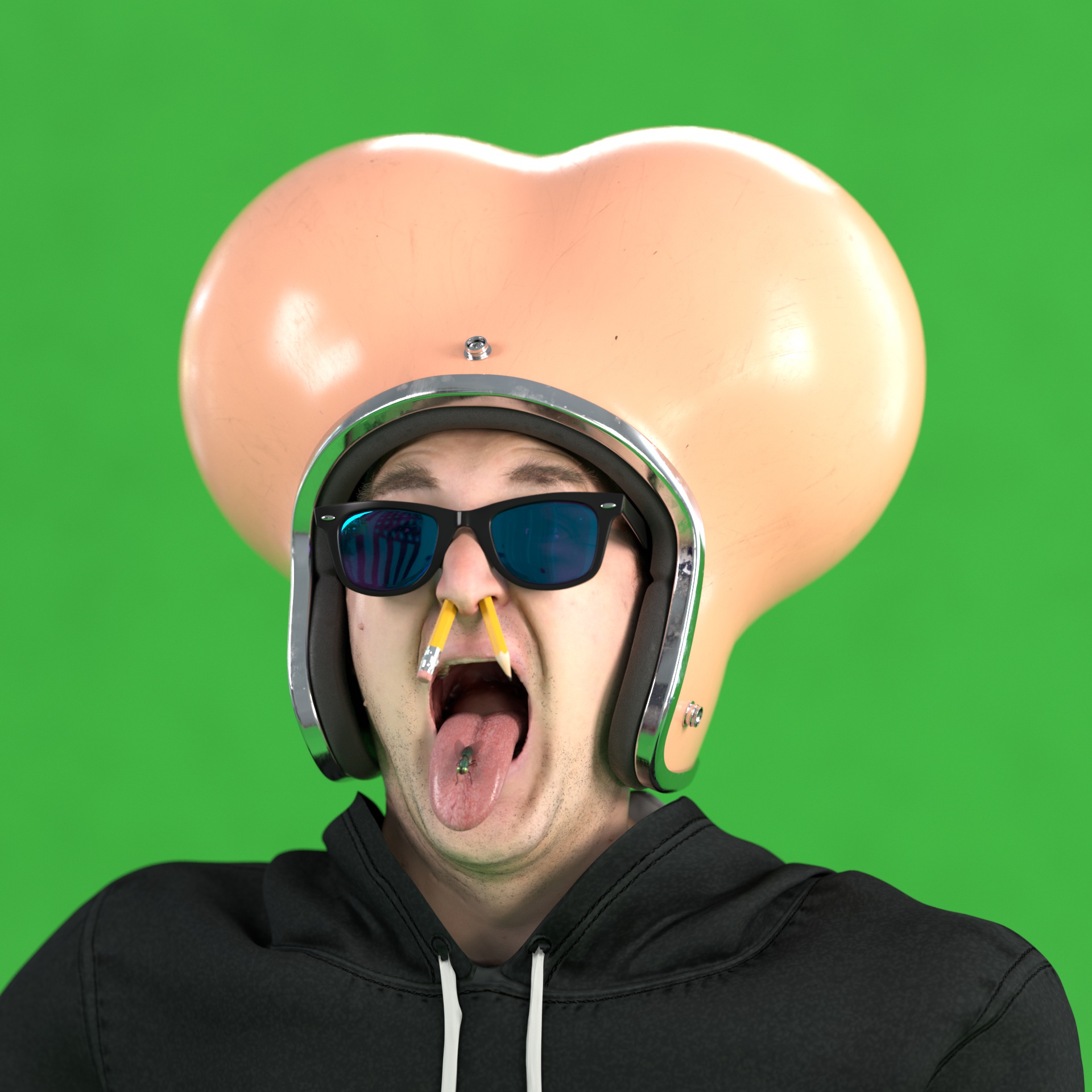NICK DENBOER
GC: You have a very interesting story. I saw your interview with Motion Plus Design channel and you told about how you left film school and then started a construction company and returned to video and VFX when YouTube eventually became the platform we all know today. Can you tell us about the evolution of your artistic journey?
ND: Yes, it has been a bit of a journey indeed. I went to art school in 1999 and it was a weird time for digital media. The curriculum was still based on very outdated VHS technology and I already was messing around with video and image making on my father’s old computer. I was also not seeing a viable path to a career at the time, or at least it didn’t feel like art school was teaching me anything I couldn’t learn on my own time for free, so I dropped out. Then, I spent a decade building my construction business but I never stopped making art. When YouTube came around I started making video remixes of infomercials, televangelists and other funny clips I recorded off the airwaves with my computer and an antenna. I was not very good at compositing at the time, but was able to make some funny videos by using a green screen and inserting myself and my friends into the videos along with some crude motion tracking. These videos got popular online and I eventually started getting job offers to make videos. I never really set out to make a career out of this, I was just having fun but eventually it turned into a career and I ditched the construction company. Starting a media company called Smearballs and making somewhat disturbing videos doesn’t seem like a successful business strategy but I don’t think it would have worked any other way.
GC: Your practice is deeply rooted in the use of visual effects (VFX), and the aesthetics of your work is a patchwork of different influences, from the internet culture as well as the remix practices, to memes, but I also found hints of vernacular videludic culture, along with the found footage. How has your artistic style evolved over time, and more importantly, what was it about VFX that captivated you so much?
ND: Indeed, it really is a mashup style. I started by making video remixes and it is still very much my process. I now have massive libraries of characters I’ve made, video footage, images, stock assets, sounds, music. It keeps growing and I use all of these things in my library to sort of remix my own work. Putting human arms on a dolphin etc… It is all cut and paste. Even before I did video, I used to go to used book stores and buy 10 copies of the same magazine so I could make distorted collages of a person with 12 necks or 7 noses. I always liked messing around with existing media to make new things. I think that sensibility is what meme culture is all about. It is reactionary. It is a conversation. Early in my career I landed a job on late night TV in America working as a bit creator for Conan O’Brien. There I learned to work fast and swim through tons of media all day and create reactionary satire clips. Immersing myself in media that I would normally never watch. Tabloid press, celebrity world, things that I avoided for my entire life. I barely watched any TV or films for my entire 20s so it was a major change to subject myself to all that media. There was definitely a cathartic aspect to messing with that footage and making reactionary satire to pop culture on that show.
VFX is so vast from compositing to 3D animation, anything I can imagine is possible so it makes all other art forms seem so limited. You can incorporate every art form into a video: music, drawing, editing, photography, acting etc. it is boundless. Today, I use dozens of software applications. I puppet characters with a mocap suit, I draw on my character’s, create tattoos and textures, I make the music to accompany my videos. It is a boundless medium and ever expanding. I love it.
GC: Let’s talk about your work Just Another Day at the Office, which you have described as a “rotating window on the modern workplace”. Each cubicle is “inhabited” by off-the-wall characters, and some represent the stereotype of “the office life” taken to extremes. It is completely surreal, grotesque, and irreverent, but when examined closely, one can grasp how this carnival of the absurd sheds light on the distortions of the so-called contemporary “corporate life”. How did the project come about?
ND: I think the initial spark of an idea to do an office piece was definitely because this was made at the peak of the pandemic and nobody was going to the office anymore. I also think there is a certain absurdity regarding the office culture. I have friends who work in the corporate world and often get a window into a world that feels very foreign and funny to me. As for the specific imagery in the scene, it is always hard to say where the inspiration comes from with my work because a piece like this was created over a month and it evolves as I make it. I start with the environment and just keep adding stuff until it is done. There is no plan, no storyboard, I don’t even write anything down. My process is entirely in the software and on the digital timeline. That said, in retrospect, I think all the characters sort of amplify the mundane nature of office culture. I just kind of keep adding stuff that makes me laugh and hopefully it gets the same reaction from those who view it.

© Nick DenBoer, Just Another Day at the Office, 2021, Installation View, DIGITAL VIDEO WALL; Metronom, Modena IT
GC: The topic of the “office life” spawned a myriad of memes that, especially since the pandemic, have highlighted the problematic nature of toxic, harassing, even exasperating dynamics. A vicious and well-established cycle from which people are trying to break out. It is no coincidence that 2022 was the year where several pics were addressed, such as different forms of quiet quitting, videos of users advising on how to handle pushy situations and over-the-top bosses, as well as users who tried to turn utterly cringe-worthy experiences they had at the workplace into ironic sketches. Can you tell us about the characters you portrayed and where you drew inspiration from?
ND: I think all the characters have a similar vibe, that is, of not wanting to be there. The man on the photocopier is some kind of obvious metaphor for who is not loving his job. The woman with the birthday cake has good intentions and plays the game but in reality she hates it. The man on the VR headset is completely in another universe, and the manager with the toilet seat is probably on the golf course somewhere. It is all very in line with the anti work movement you describe I suppose. I guess I get some inspiration from stories from my friends who work in the corporate world, but some inspiration is purely technical. Learning to do soft body simulations in houdini (3d simulation software) struck the idea of having a man jiggle as he bounces on a photocopier. I find I learn new technical skills and it leads to funny ideas.
GC: Your work is quite diverse, from commercials for several globally known companies, such as Red Bull, to Conan O’Brien’s show on TBS, or collaborations such as the one with Tommy Lee. The common thread linking the different expressions of your practice can be traced to VFX comedy. Yet, there are also productions that, beyond the ironic veneer, offer a blunt and direct point of view on the social and political distortions of the contemporary world. I am thinking, for example, of videos such as American Exceptionalism I and II, The Expressionist (which reminded me of a scene in Paolo Sorrentino’s film The Great Beauty in which there is an ironic reference to Marina Abramovich and performance art, in which this artist Talia Concept “lives on vibrations” and eventually runs into a wall during a performance), Reverse Evolution, Skin & Bones. These are both visual and sound loops populated by grotesque caricatures of the clichés we witness on a daily basis, but the way you portray them is very subtle, close to the saying “few words to the wise”. Can you tell us about this kind of videos in more detail? How come you decided to make NFTs out of them?
ND: Not sure I’ve ever heard my videos referred to as “subtle” but I get what you mean with having a subtext. All the videos you reference were made this past year or so. The explosion of the digital art market through NFTs kind of brought me full circle. I gave up on fine art when I dropped out of art school in 2000. I never really thought about galleries and selling art in recent years. Digital art was not viable 20 years ago. Selling a limited edition DVD of your work seemed cheap and sort of ridiculous. This new way of making and potentially selling digital art was really appealing to me, so I took a lot of time off of client work in the last while to focus on making art. The market was really tainted with all the ridiculous inflated collectible garbage and greed, which made it hard to identify as an NFT artist in the last year but I hope that a digital fine art market survives in the future and keeps evolving.
I like making loops because a lot of my work has so many details that you need to watch it multiple times to take it all in. Also for someone to hang a time based piece on their wall, it makes more sense to have a looping image with no in or out point. Some of my loops have edits still but a lot of them are seamless and meant to be observed for as long as the viewer feels like it.
Conceptually, I suppose I am attracted to the grotesque, but I’m not a big blood and gore horror fan or anything. I just think these grotesque images are funny. Most of this stuff just makes me laugh or gives me an uncomfortable reaction. I think there is beauty in the grotesque. I like to think I make aesthetically appealing yet grotesque work. Maybe it is a bit of a paradox.
GC: Visual effects and animation play a key role in your video production, as does music. The Digital Video Wall is devoid of any sound, but each of your works features a completely personal beat. I would like to ask you what editing and VFX programs you use and, finally, what were your musical influences and how you slowly developed your sound style.
ND: I started out with making musical remixes from video clips. Taking audio samples from a video, making a musical hook with it, bouncing back and forth between music and video software so my work has always had a strong musical-visual link. Nowadays, making the music is the fun part after doing all the tedious visual work; it is fun to score the visual and make the music as an afterthought. Lately, I just animate to a certain BPM and make sure all my animation lands on a certain tempo and maybe have a scratch drum track that I use to animate too but I save the music for later generally.
Software-wise, it is pretty vast. My main software is Cinema 4D. That is where all my scenes are built and I render with Octane render which I love the look and realism I can achieve with. But I also use Houdini for simulations, Reallusion for character creation, Rokoko for motion capture, Zbrush for modeling and character detail, Substance painter for texturing, Reality capture for photogrammetry, Clip Studio for drawing / digital painting, Topaz for upscaling and frame interpolation, Cubase for music, Premiere and After Effects for editing and compositing, and all kinds of various plugins and tools for all of the above.
To be honest I don’t really draw a lot of influences on the music side of things. I just kind of spit stuff out when the time comes and it is what it is. I always saw my music as an accompaniment to the visuals or part of the video. I released an album of remixes a couple of years ago that has a lot of old hip hop samples, which was what I grew up listening to, so I guess that was always an influence hearing sampled/remixed work in my youth.

Nick DenBoer, Just Another Day at the Office, 2021, Video Still
GC: I can’t help but ask about the production of The Chickening (2016). You turned The Shining (1980) movie into a wildly, out-of-control alternate world populated by chickens and wacky characters. Some iconic scenes from Kubrick’s film have been reimagined with irony, a pop and weird streak. I’m thinking of the ones of the twins, here in rap funk attire, the bathtub scene, starring a chicken man, and Danny traveling the corridors on a tricycle that is very reminiscent of some levels in the video game Crash Bandicoot. Can you tell us about how this work and its editing process came about?
ND: The Chickening was actually a proof of concept for a TV show. After working on Conan O’Brien, I had the opportunity to pitch a show to Warner Bros; they have this magnificent classic film library. The idea was every episode would be a different film reimagined as something with an entirely new narrative by adding a layer of VFX. Unfortunately, it didn’t work out. A combination of copyright red tape and Kubrick estate not being interested in us ruining their film put an end to it. But the film got a life of its own in the film festival circuit. It has been shown all around the world in over 150 film festivals including Sundance and TIFF.
The idea came about because I met my friend Davy Force many years ago and he is an amazing remix artist so we always planned on doing a big remix project together. We joined forces and started hashing scenes together and editing the dialogue and filling it in to start carving out a new story. It is a lot of fun writing on the editing timeline and sort of skewing the dialogue. It is a lot of trial and error, dissecting the dialogue and rearranging it to fit your new narrative. It is a sort of fluxus writing process with the added layer of visual effects. We cast our friends and layered mouths over top of the existing characters to fill in the gaps and guide the narrative. In the end, we had around 10 or 15 minutes of the 30’ and it was unfinished, so I cut it into a trailer.
GC: On a last note, I gotta ask, what’s the story behind the name Smearballs and the signature balls?
ND: Haha, well Smearballs actually started as a blog. My friend Erin Zimerman and I began posting on it as a joke site. The smear part of it was very suited to our early videos, green screening ourselves into infomercials and messing with existing content in a sort of smear campaign. We invited more friends to post on the blog over time. I originally sort of envisioned it as a collective but eventually some lost interest and I didn’t want to be the boss of a group where I had to encourage others to make work and drive a group vision and, eventually, I went solo with it as people were hiring Smearballs to make videos; why not run with it. But in the end it was just me. In retrospect I would have never created a solo art brand with such a ridiculous name but my style suits the absurdity and at this point it is just funny to me and although I’m sure I have lost many jobs because of the name, I have also got a lot of really cool opportunities and collaborations because of the absurdity of the brand.
05/01/2023

Nick DeBoer, Just Another Day at the Office, 2021, Installation view, DIGITAL VIDEO WALL, Metronom, Modena, IT

